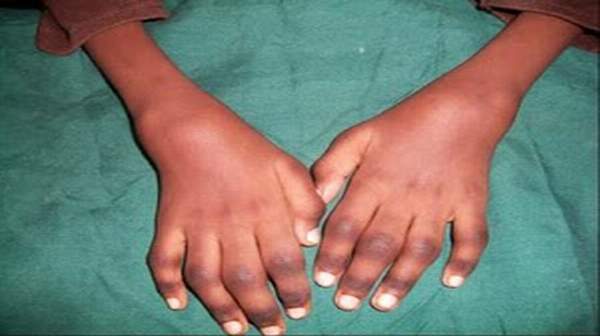Juvenile rheumatoid arthritis, also known as juvenile idiopathic arthritis, a type of arthritis that happens in children age 16 or younger. Juvenile rheumatoid arthritis causes persistent joint pain, swelling and stiffness. Some children may experience symptoms for only a few months, while others have symptoms for the rest of their lives. Juvenile rheumatoid arthritis is an autoimmune disorder, which means that the body mistakenly identifies some of its own cells and tissues as foreign. The immune system, which normally helps to fight off harmful, foreign substances such as bacteria or viruses, begins to attack healthy cells and tissues. The result is inflammation, marked by redness, heat, pain, and swelling.
Types
- Polyarticular JRA: It affects more girls than boys. The small joints of the hand and the weight-bearing joints are affected. There is swelling or pain in minimum 5 joints.
- Pauciarticular JRA: The knee and wrist joints are generally affected. Inflammation of maximum four joints is observed. Additionally, the iris may be inflamed with or without active joint symptoms.
- Systemic JRA: There is initial fever that increases in the evening and abruptly comes back to normal. During fever, the child may develop a rash. This rash may all of a sudden disappear and reappear. The spleen and lymph nodes increase in size. Finally, many joints of the body are inflamed.
Causes
Juvenile rheumatoid arthritis occurs when the body’s immune system attacks its own cells and tissues. It’s unknown why this happens, but both heredity and environment seem to play a role. Certain gene mutations may make a person more susceptible to environmental factors such as viruses that may trigger the disease.
Symptoms
History findings in children with juvenile rheumatoid arthritis may include the following:
- Arthritis present for at least 6 weeks before diagnosis (mandatory for diagnosis of JIA)
- Either insidious or abrupt disease onset, often with morning stiffness or gelling phenomenon and arthralgia during the day
- Complaints of joint pain or abnormal joint use
- History of school absences or limited ability to participate in physical education classes
- Spiking fevers occurring once or twice each day at about the same time of day
- Evanescent rash on the trunk and extremities
- Psoriasis or more subtle dermatologic manifestations
Complications
Several serious complications can result from juvenile rheumatoid arthritis. But keeping a careful watch on your child’s condition and seeking appropriate medical attention can greatly reduce the risk of these complications:
- Eye problems. Some forms of juvenile rheumatoid arthritis can cause eye inflammation (uveitis). If this condition is left untreated, it may result in cataracts, glaucoma and even blindness.
- Eye inflammation frequently occurs without symptoms, so it’s important for children with juvenile rheumatoid arthritis to be examined regularly by an ophthalmologist.
- Growth problems. Juvenile rheumatoid arthritis can interfere with your child’s growth and bone development. Some medications used to treat juvenile rheumatoid arthritis, mainly corticosteroids, also can inhibit growth.
Diagnosis
The doctor demands a detailed medical history and conducts a thorough physical examination. X-rays and blood tests are done to exclude other conditions that have similar symptoms. Other tests are as follows:
- Complete blood count to evaluate basic cellular components of blood, like red blood cells, white blood cells, and platelets
- Blood culture to determine the presence of bacteria in the bloodstream
- Bone marrow examination to test blood in the bone marrow for deciding about leukemia
- Test to check the erythrocyte sedimentation rate, which increases with inflammation
- Test to check the rheumatoid factor, which is an antibody produced in the blood of children with some type of JRA
- Antinuclear antibody is used to detect autoimmunity and the possibility of eye disease with JRA
- Bone scan to determine alterations in bone and joints to analyze the reasons of unexplained bone and joint pain
The primary care physician, rheumatologist, and the physical therapist collaborate and design a combination of medication, physical therapy, and exercise.
- Medication. Non-steroidal, anti-inflammatory drugs (NSAIDs), like ibuprofen (Advil, Motrin, or Nuprin), aspirin, naproxen or naproxen sodium (Naprosyn or Aleve) limits the release of harmful chemicals from white blood cells, and thereby, decreases inflammation and pain. If NSAIDs are not effective, the doctor may recommend other new medications. Sometimes, Disease-modifying anti-rheumatic drugs (DMARDs), like methotrexate are used to slow the progression of JRA. However, these require weeks or months to relieve the symptoms. Those having severe JRA are treated with Corticosteroids, like prednisone to control severe symptoms, like inflammation of the sac surrounding the heart. This medication is given through the mouth or directly into the vein.
- Physical Therapy. Certain range-of-motion exercises are recommended to regain flexibility in stiff and sore joints. Other exercises enable to build strength and endurance.
- Regular Exercise. In the presence of pain, children desire to lie down still. However, it is vital to follow a regular exercise program. Strong and healthy muscles support and protect joints. Walking, swimming, and bicycling (outdoor or indoor stationary) must be executed. Before exercise, a warm-up is necessary. A balanced diet involving a lot of calcium promotes bone health.
Caregivers can help children learn self-care techniques that help limit the effects of juvenile rheumatoid arthritis. Techniques include:
- Getting regular exercise. Exercise is important because it promotes both muscle strength and joint flexibility. Swimming is an excellent choice because it places minimal stress on joints.
- Applying cold or heat. Stiffness affects many children with juvenile rheumatoid arthritis, particularly in the morning. Although some children respond well to cold packs, most children prefer a hot pack or a hot bath or shower.
- Eating well. Some children with arthritis have poor appetites. Others may gain excess weight due to medications or physical inactivity. A healthy diet can help maintain an appropriate body weight.
Adequate calcium in the diet is important because children with juvenile rheumatoid arthritis are at risk of developing weak bones (osteoporosis) due to the disease, the use of corticosteroids, and decreased physical activity and weight bearing.





